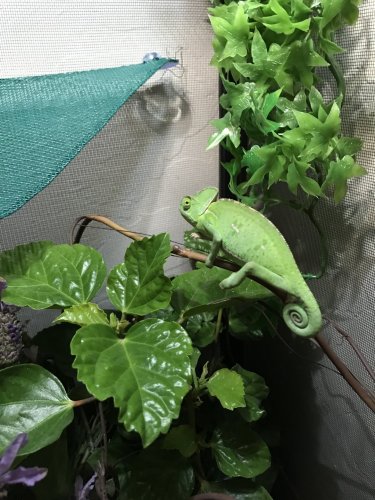delaneydolan
New Member
Chameleon Info:
Cage Info:
Current Problem - Okay so I am concerned because I just got my girl about a week ago, and so far I’ve never caught her eat or drink. I’ve seen her open her mouth once. I have been putting food in but I am having a hard time being able to tell if she’s eaten, if she has its not much. Most of the time she’s a bright green even when being handled, but every once in a while she gets dark spots and a darker green. This usually happens when she’s at the bottom of her cage but almost never happens when she’s handled or at the top of her cage. Is she okay?
- Your Chameleon - Veiled Chameleon, pretty positive it’s female, and not sure on age but young for sure.
- Handling - About once a day. She seems totally calm and content with being handled and isn’t puffed up or unusually dark.
- Feeding - I’ve been attempting to feed her crickets and mealworms, dusted with calcium without D3 and I also have bought calcium with D3 and plan to use it 2x a month (I’ve only had her for about a week). I feed her about 5 crickets or mealworms a day, but haven’t seen her eat (although I have been struggling to count the remaining crickets at the end of the day). I haven’t gut-loaded but I definitely could, I’m just concerned with her eating habits.
- Supplements - I’m dusting the feeders with ZooMed Repti Calcium without D3 and with D3 2x a month.
- Watering - I keep a very (!) shallow bowl of water that I’ve seen her in a few times and mist 3-5x daily.
- Fecal Description - Brown and a bit slimy but compact. White/yellowish tip.
- History - I wasn’t given any history other than that the pet store fed her 5 crickets 2x a day.
Cage Info:
- Cage Type - All screen, 16"x16"x30”,
- Lighting - ZooMed UVB light and daylight blue light.
- Temperature - The overall cage temp it 72-75 degrees, and basking is 80 ash, bottom is 65-70 in the daytime. The lowest temp is 60 ish at night. I keep a probe thermometer to measure these.
- Humidity - I’m not sure what my humidity levels are exactly, but i mist often and I have a reptile bark in the bottom as I was told it would retain humidity. I will be getting a hygrometer.
- Plants - Plants are artificial.
- Placement - Cage is located near a window in my bedroom, but the blinds are almost always closed. There is a fan in the center of the room but not directly over her, and the air duct is across the room, the room is quiet most of the time. The cage is on a table and the top is about four feet from the floor.
- Location - I live in Tucson, Arizona
Current Problem - Okay so I am concerned because I just got my girl about a week ago, and so far I’ve never caught her eat or drink. I’ve seen her open her mouth once. I have been putting food in but I am having a hard time being able to tell if she’s eaten, if she has its not much. Most of the time she’s a bright green even when being handled, but every once in a while she gets dark spots and a darker green. This usually happens when she’s at the bottom of her cage but almost never happens when she’s handled or at the top of her cage. Is she okay?







